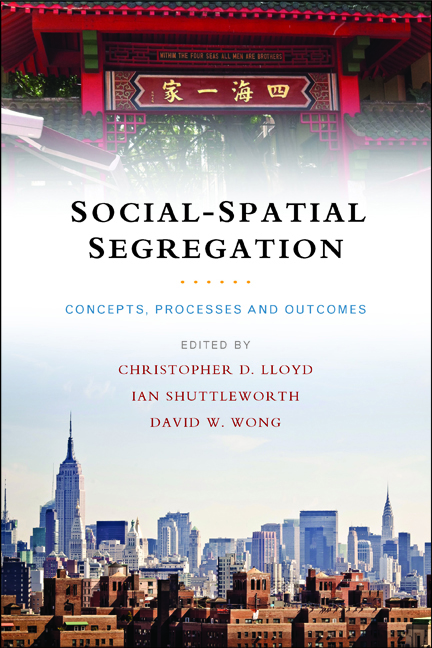three - Using a general spatial pattern statistic to evaluate spatial segregation
Published online by Cambridge University Press: 04 March 2022
Summary
Introduction
Many indices proposed by social scientists to measure segregation have been criticised for their aspatial nature, failing to distinguish different spatial patterns of population effectively. During the past two decades, a series of spatial measures have been proposed to address this deficiency. However, most of these measures adopt the ‘smoothing’ approach by including populations in the neighbouring units when comparing racial-ethnic mix across areal units. The actual separations among populations over space are not considered. In this chapter, a newly proposed general measure of spatial patterns based on proximity was modified to measure racial-ethnic segregation. To demonstrate the utility of this measure, it was used to evaluate the spatial separations between population groups in hypothetical landscapes and Washington, DC, based on the 2000 and 2010 Census data. While the proposed measure shares some conceptual similarities with the proximity index proposed several decades ago, it has a statistical foundation that its value can be tested for significance. However, the current testing procedure is not highly robust. This chapter also discusses several conceptual issues in measuring segregation, including the nature of segregation and its relations to clustering.
As pointed out by Johnston et al in Chapter Two of this volume, to be able to measure segregation level accurately is critical in determining if segregation matters. However, how segregation can be and should be measured is very much dependent on our conceptualisations of segregation. Numerous segregation indices or methods for assessing the level of segregation have been introduced. Each of them, either implicitly or explicitly, adopts specific or multiple conceptualisations of segregation. In other words, segregation is multidimensional (Massey and Denton, 1988) and multifaceted (Peach, 1996). Thus, results from different measures may complement each other, but they may not be comparable, as they likely reflect different aspects of segregation. Several scholars have assessed the number of ‘effective’ dimensions of segregation (see, for example, Reardon and O’Sullivan, 2004; Brown and Chung, 2006). While thoroughly assessing this topic is beyond the scope of this chapter, and the focus here is on improving segregation measurement along the spatial dimension, only the clustering dimension of segregation will be dealt with as it is more spatial than other dimensions of segregation. Specifically, the objective of this chapter is to evaluate how different population groups are spatially separated.
- Type
- Chapter
- Information
- Social-Spatial SegregationConcepts, Processes and Outcomes, pp. 45 - 64Publisher: Bristol University PressPrint publication year: 2014



